The long-lost screen appearance of the original stage Sherlock Holmes, this 1916 film re-emerged in France after being thought lost for nearly a century. Will William Gillette’s take on Sherlock Holmes live up to its reputation? We’re about to find out!
Inventing Mr. Holmes.
Like just about everyone else in the classic movie world, I was absolutely ecstatic to hear that the 1916 version of Sherlock Holmes had surfaced in France and was being restored for all the enjoy. The recovery of any lost film is a cause for celebration but this film was a particularly sought-after item. It was based on a smash hit play and its playwright and star, William Gillette, had created the look and mannerisms that we now consider to be quintessential to the character of Holmes. The 1916 adaptation of his play was his only motion picture appearance.
To make things more interesting, the 1922 film version of Gillette’s play, which starred John Barrymore, Roland Young, William Powell, Carol Dempster and Hedda Hopper, was itself nearly lost and had to be cut back together from a mountain of unedited footage. While other motion picture versions of Holmes would either dip into the original Arthur Conan Doyle stories or would blaze their own trail, the 1922 Holmes was a direct remake of the Gillette version.
So, we’re going to be examining the Gillette version and discuss whether or not its reputation is deserved. Then we are going to compare it to the 1922 glamorized Barrymore vehicle and discuss how Hollywood made the Gillette-penned Holmes sexier for the Roaring Twenties. Since the background of the Gillette play and his importance in the development of the Holmes character have been discussed extensively elsewhere, I will be focusing on the cinematic aspects of the film and how they measure up to other films of the period. In short, this review is a silent movie nerd review and not so much a Sherlockian review.
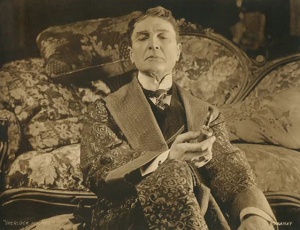
The Gillette play was not based on one particular Holmes story but is a potpourri of story elements from the Holmes canon as it stood in 1899. At that point, the famous detective had been killed off by his creator (in 1893’s The Final Problem) and would not be properly resurrected for another four years. Holmes fans will enjoy figuring out which character and plot element came from which story but, again, this is not going to be the focus of our review today. However, it is important to realize that the Gillette Holmes would have been a balm to audiences mourning the death of the world’s greatest detective.
(Doyle wanted to write historical fiction and had no plans to revive Holmes initially. Incidentally, I find Doyle’s historical fiction to be uneven. He has colorful characters but he tends to dwell in minutia and allow genuinely exciting events to be told as flashbacks once the characters are elsewhere, safe and sound.)
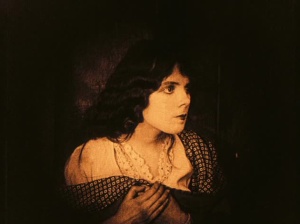
The story of Sherlock Holmes concerns Alice Faulkner (Marjorie Kay), a young woman whose sister was the lover of a European nobleman. Upon her sister’s death, Alice inherited certain incriminating letters and a grudge against the nobleman. Alice blames him for her sister’s death but she seems a little too nice to be a blackmailer.
The nefarious Larrabees (Mario Majeroni and Grace Reals) have no such compunctions holding them back. Thanks to the paper-thin walls of the room where Alice is staying (shoddy construction!) the Larrabees hear everything and decide to obtain the letters for themselves. They trick Alice into staying at their house and attempt to discover where she is hiding the valuable documents.
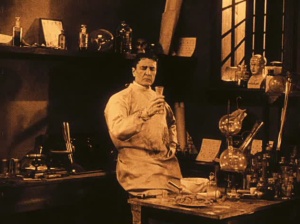
Meanwhile, the nobleman and certain high British officials have retained the services of Sherlock Holmes (Gillette) to get the letters from Alice. Holmes takes time out of his busy schedule of pouring liquids from one test tube to the other and agrees to help. He calls on the Larrabees, determines the safety of Alice, tricks her into revealing the hiding place of the letters but does not take them from her because she’s kinda cute. He then warns the Larrabees not to harm her and leaves her there.
Um…. Okay then… None of this makes sense but there it is.
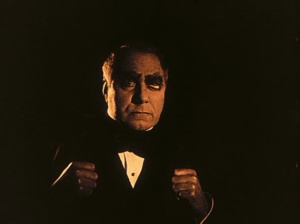
Anyway, the Larrabees are suitably spooked by their run-in with Holmes and decide to call in the heavy guns. Professor Moriarty (Ernest Maupain) is the spider at the center of London’s criminal web, as shown by the fact that his lair is dark and dank and not at all cozy. (Seriously, these criminals never think of day-to-day comfort when they design their hideouts. How can you take a proper tea break in that dingy hole?) He also has an incinerator built into his desk, which you would think would be key to the plot but isn’t.
Moriarty immediately sets about trying to get Holmes out of the way in a permanent manner. Holmes is a few steps ahead of him, of course, but poor Dr. Watson (Edward Fielding) is fooled a few times. And then there is the fact that Holmes still has his eye on Alice Faulkner and his interest is not limited to her role in his case…
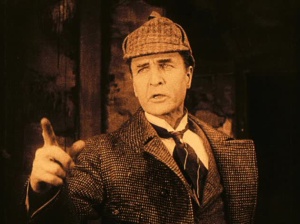
To modern eyes, Gillette’s Holmes seems middle-of-the-road but this is because he really invented many of the classic Holmes mannerisms. In short, it’s like saying that Coca-Cola has a typical cola taste or that Heinz ketchup is typical ketchup. Um, yes. Basically, Gillette set the Holmes standard so saying that his Holmes is typical is stating the obvious. What’s fun about watching Gillette is seeing how fully-formed the classic Holmes character was in his interpretation.
I will say this, though: Gillette’s Holmes is the worst boss ever. His agents are constantly getting waylaid, attacked, beaten and abused and what does he do? (Shrugs) “Not my problem, I’m busy pouring liquid from test tube to test tube.” In one case, an agent is attacked right outside 221B and Holmes can’t be bothered to help. Someone call OSHA on this man, I am pretty sure he is in violation of more than a few codes.
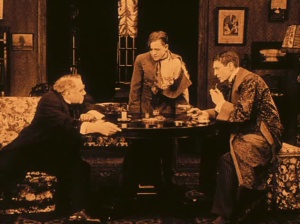
Essanay clearly did not want to mess about with a winning formula. A shame they didn’t follow this philosophy in their dealings with Charlie Chaplin but that is another story for another day. Basically, Gillette and his co-stars put on their popular play (then 17-year smash hit) with few changes to accommodate the motion picture medium. This proves to be the picture’s fatal flaw.
The beauty of silent cinema is that it straddles motion pictures and novels. It is a smart, economical style of moviemaking and one brief title card or one flick of the eyelid can tell more than pages and pages of dialogue. Gillette and the Essanay crew did not take advantage of this economy and recite the play as-is. This means we get long stretches of people chattering away at one another– too fast for the standard silent movie lip-reading– and few title cards to help us along. We are also given dialogue and description cards but we are not really given access to the characters’ inner lives, which would have been a welcome addition for the somewhat opaque character of Alice.
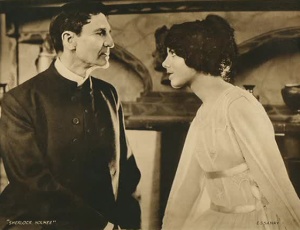
Further, director Arthur Berthelet seems uncomfortable with such basic cinematic devices as the cut and the close-up. For example, we see all the characters grouped together in one frame (audiences are paying to see whole actors, darn it, so show their feet!) and then they pause and we fade into a medium shot, they pause again and we fade into the see-their-shoes shot once again. It’s very clunky and editing in American cinema was considerably more advanced at this point. Compare the work of Maurice Tourneur, Cecil B. DeMille, John Collins, Raoul Walsh and William S. Hart at this point in film history and you will see that they leave Berthelet in the dust. Compare the snappy editing that was going on at Keystone, which was hardly a bastion of cinematic snobbery.
So now we have an interesting comparison. How does the 1916 film measure up to its 1922 direct remake? I have to give a slight advantage to 1916 and I will explain why. (Before we get started, let me remind you that both films were rescued in less-than-ideal condition and so a slight amount of narrative choppiness is expected.)
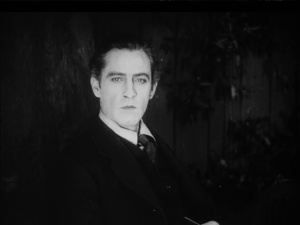
The 1922 version starred John Barrymore and, in what was no doubt a bit of vanity stroking, casts him as a college student at the opening of the tale. (Barrymore was forty at the time.) This also serves to break up the story and lose narrative urgency as everything has to be put on hold in time for our hero to graduate. (Please stop showing us Sherlock Holmes, college student. Looking at you, Young Sherlock Holmes. Good lord, I hated that movie.)
The film also makes the fatal error of introducing Alice (Carol Dempster) as Barrymore’s love interest before the letter scandal blows up. So out of all the universities in all the towns in all the world, Holmes falls for the very woman who will be key to his case? Matters are not helped by the fact that Barrymore and Dempster have so little chemistry that they seem more like siblings than lovers. (I fault Dempster as Barrymore rarely had trouble igniting a spark with his co-stars, at least in his prime.)
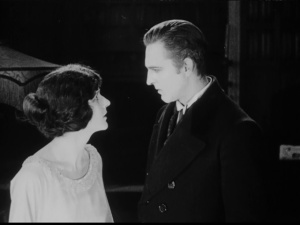
However, the 1922 version has one distinct advantage over the 1916 film: the supporting cast. With the exception of Mr. Gillette, none of the 1916 cast is particularly memorable. These people are not household names for a reason is my point.
1922? Roland Young is Dr. Watson, William Powell plays one of Sherlock’s agents, acclaimed silent film baddie Gustav von Seyffertitz is Professor Moriarty and Hedda Hopper is Mrs. Larrabee. Wow.
Of course, both films have a problem with their source material. I am very sorry to Mr. Gillette but… his play just isn’t very good. With the exception of Holmes, no one seems to have an inner life and Alice is a rather dull love interest. Are we to believe that Holmes pass by Irene Adler and Violet Hunter but fall for her? (Admittedly, Alice is an amalgamation of several Holmes women, including Adler, but she’s still not very interesting.) Further, Moriarty doesn’t do much to prove himself as a criminal mastermind. In short, our impression is: “This guy killed Holmes? Him? I refuse to accept this.” And his habit of dumping poisoned corpses into the Thames has got to make him pretty unpopular with the city of London, let me tell you.
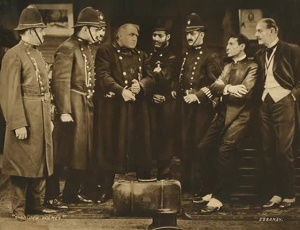
Returning to discussing the 1916 film in isolation, it’s not bad by any means but with a little more care from Essanay and a little more understanding of film vs. stage it could have been a masterpiece. We basically have a stagy, set-bound movie with one dynamic performance as the centerpiece.
As for the more technical aspects of the home media edition, the restoration looks fabulous, of course, and the original tinting scheme was restored for the film’s second debut. Special praise is reserved for the score, a trio consisting of piano, violin and percussion composed and performed by Neil Brand, Guenter Buchwald and Frank Bockius. The violin in particular makes things appropriately Sherlockian and there is an aural hat-tip to the theme music of the Granada series starring Jeremy Brett. The score is stylish, moody, smart and infuses just enough jazziness to keep things fresh. It helps considerably when the pace of the film is flagging, which it often does.
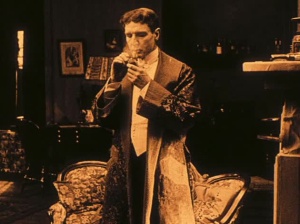
So, was this film worth the wait? Most certainly. While it has its flaws with pacing and staginess, it is worth it to catch a glimpse of Gillette’s important contributions to the Holmes legend. Eille Norwood remains the silent Holmes extraordinaire but like every other Holmes who came before or after, he owes at least something to Mr. Gillette. This is a valuable piece of movie history and is absolutely worth your time.
Movies Silently’s Score: ★★½
Where can I see it?
Sherlock Holmes was released as a DVD/Blu-ray combo by Flicker Alley. The set is simply stuffed with extras, including three off-brand Holmes shorts, vintage marketing materials and other goodies. Highly recommended and one of the best fully-loaded silent releases of the year.

Irony: While working as a juvenile actor in London at the start of his career (c. 1905), didn’t Chaplin have a bit as the page boy in a London staging of Gilette’s Sherlock Holmes–long before it appears both of them were on the Essanay lot at almost the same time?
I imagine the silent film lots had many, many meetings of old friends. My timing may be off but I believe Gillette would have just missed Chaplin.
I believe that Chaplin played Billy the page boy in a one-act play used as a curtain raiser for the Gillette play. Someone may be able to add more details. It exists as a script.
I meant that Chaplin’s time at Essanay didn’t overlap Gillette’s. Chaplin’s contract ended in December of 1915 and Gillette’s began in early 1916.
The one-act play was called “The Painful Predicament of Sherlock Holmes,” and according to the program, Billy was played by “Master Charles Chaplin.”
Very balanced review. A significant film in spite of the cinematic flaws. I enjoyed the comparison with the 1922 film with John Barrymore.
Thank you. I do think it’s a mistake for people to conflate rarity with quality. This is a pretty good movie with massive historical importance. It’s just a shame that the Essanay team didn’t work harder to adapt it for the screen.
While I rather enjoyed this film, I do agree it has a number of flaws, mainly the dull Alice and the lack of cinematic flair. Still, I enjoyed Gillette and actually enjoyed the slower pacing. And I think it is much better than the Barrymore version, which had an intertitle overload and Dempster.
Yes, Gillette and Kay have something resembling screen chemistry. The 1922 version simply fiddled with the formula but they didn’t change any of the stuff that actually needed to be changed.
Thank you! The title “The Painful Predicament of Sherlock Holmes” was on the tip of my tongue, but wouldn’t emerge. I once owned a copy. Gillette had no dialogue in this as I recall.
Looking forward to this dropping through my letterbox, after however long it takes to make it across the Atlantic! Even if it isn’t great, it sounds unmissable. I also only watched the Barrymore version a few months ago, so it’ll be interesting to compare.
Yes, it’s definitely one to see! I found it very fun to compare versions and I’m sure you will like it too. 🙂
I saw this at the San Francisco Silent Film Festival this year (a sold out performance) and it confounded my expectations. I expected the film to be okay, but that Gillette would not come off so well with his stage traditions.
Instead, as you note, the film itself is not even up to the cinematic standards of the time. Gillette, however, is remarkable. Rather than giving an over-the-top stage-bound performance, he is (IMHO) surprisingly low-key and nuanced (though that reaction may be relative to his surroundings and my expectations).
Gillette is the only reason to see this, but it’s well worth it just for him.
Oh yes, definitely. Gillette lives up to his hype (hurrah!) it’s a shame that the rest of the film was not quite so hot but all in all, a very nice experience.
I find it so incredible that in the world of today old films can still be discovered. You would think that in our world, everything is known and available.
Though I didn’t see the film yet, I think we are so lucky having the possibility to see Gillett ‘on stage’. His work was so essential to the image we still have of Holmes. I find it fascinating when we have the possibility to see an icon being created.
Thanks so much for sharing.
Yes, it was an amazing find. 🙂
I got to see at the Mostly Lost festival this Spring, and while I’m glad I got to see it, and recognize its importance, I was surprised at how far removed it is from the literary version. I suppose I incorrectly believed it would be more faithful to the original by virtue of being in Conan Doyle’s lifetime.
At the time, Doyle had killed Holmes and was in the midst of running around shouting “Free! Free!” so he let Gillette pretty much do whatever he liked with the character.
I’ll have to check my dates, but I thought Conan Doyle had resurrected Holmes by then.
The original Gillette play Sherlock Holmes, upon which the film is based, was first performed in 1899. Holmes was killed in The Final Problem (1893) and was resurrected in The Adventure of the Empty House (1903). The Hound of the Baskervilles was published in 1902 but Doyle made it clear that it was set before Holmes was killed.
An excellent and timely review, as I recently watched this. I don’t know much about Holmes, but I’m glad I got to see it from a historical perspective. I enjoyed Gillette’s performance, and Moriarty’s as well, but I didn’t find the story that engaging.
Thank you! Yes, I think that’s pretty much the universal consensus: historically valuable, strong central performances but lacking some story oomph.